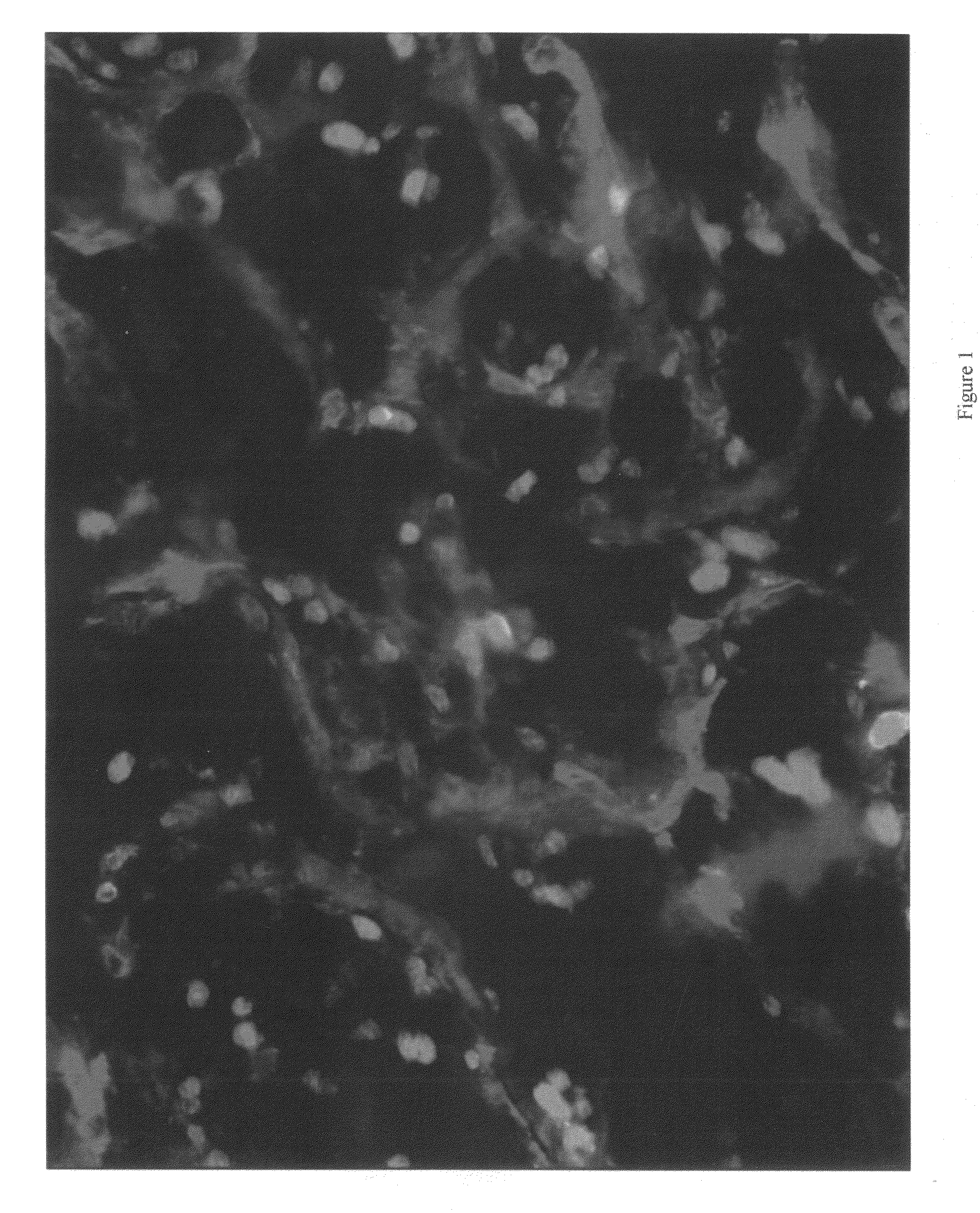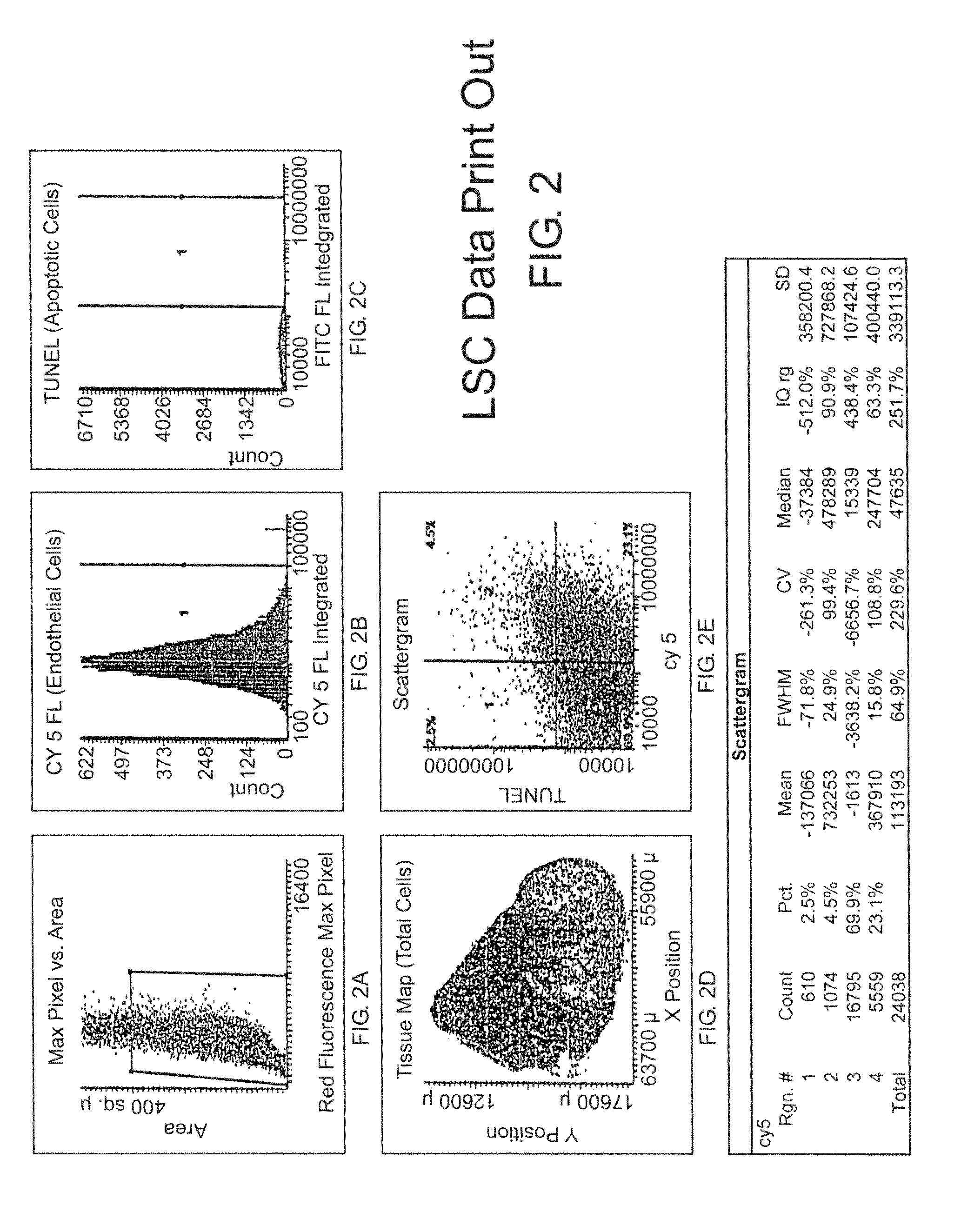Laser scanning cytometry mediated analysis of therapeutic efficacy in tumors
a technology of laser scanning and cytometry, applied in the field of cancer diagnosis and treatment, can solve the problems of large technical training, increased growth and metastasis in other parts of the body, and body does not acquire resistance to anti-angiogenic compound treatment,
- Summary
- Abstract
- Description
- Claims
- Application Information
AI Technical Summary
Benefits of technology
Problems solved by technology
Method used
Image
Examples
example 1
ROCEDURES
[0159]Tumor specimens or patient biopsies are obtained prior to and several time points post-treatment such as 1, 3, and 7 days or more. Tissue sections are stained using an immunofluorescent double-labeling technique which permits the simultaneous detection of endothelial cells and fluorescent markers of apoptosis such as TUNEL or caspase activity. The tissue sections are scanned by the LSC and cell data is collected by the instrument's software. For the first scan, the Wincyte software is setup by the user to contour on the cell nuclei based on propidium iodide staining. Contouring on the cell nuclei provides the total cell number of the tissue specimen and creates a ‘tissue map’ which permits selective gating of the tumor cells. In addition, contouring on the cell nuclei permits the software to identify endothelial cells (based on CD31 and / or CD34, Pharmingen, Inc., fluorescent staining) and / or TUNEL positive cells (based on fluorescent TUNEL, Promega, Inc.). This data p...
example 2
ORESCENCE DOUBLE STAINING
[0160]Formalin-fixed, paraffin embedded sections (5 μm) are deparaffinized in xylene, rehydrated in alcohol, and transferred to phosphate-buffered saline (PBS). Antigen retrieval is performed with 200 μg / ml proteinase-K for 30 minutes at room temperature. Frozen tissue sections (8 μm) are fixed by sequential incubation with cold acetone, acetone plus chloroform (1:1), and acetone (5 minutes each). Although frozen sections are usually easier to stain, both frozen and paraffin sections are used because paraffin sections are more convenient for clinical analysis. Sections are washed three times with PBS (5 minutes each) and incubated for 20 minutes at room temperature with protein blocking solution containing 5% normal horse serum and 1% normal goat serum. The blocking solution is removed and the sections are incubated for 24 hours at 4° C. with a 1:400 dilution of rat monoclonal anti-mouse CD31 antibody. Staining conditions may have to be optimized for some of...
example 3
NNING CYTOMETRY
[0163]Immunofluorescence microscopy is performed on an epifluorescence microscope equipped with narrow bandpass excitation filters mounted in a filter wheel to individually select for green, red, and blue fluorescence. Images are captured using a cooled CCD camera and SmartCapture software. Images are further processed using Adobe Photoshop software.
[0164]The LSC (CompuCyte, Corporation, Cambridge, Mass.) is an instrument designed to enable fluorescence-based quantitative measurements on tissue sections or other cellular preparations at the single cell level. The instrument consists of a base unit containing an Olympus BX50 fluorescent microscope and an optics / electronics unit coupled to argon and HeNe laser support elements and a computer. Tissue sections that are mounted on a solid surface (i.e., a glass microscope slide) are interrogated by a 5 μm-diameter argon laser that repeatedly scans along a line as the surface is moved past it on a computer-controlled motori...
PUM
| Property | Measurement | Unit |
|---|---|---|
| size | aaaaa | aaaaa |
| diameter | aaaaa | aaaaa |
| time | aaaaa | aaaaa |
Abstract
Description
Claims
Application Information
 Login to View More
Login to View More - R&D
- Intellectual Property
- Life Sciences
- Materials
- Tech Scout
- Unparalleled Data Quality
- Higher Quality Content
- 60% Fewer Hallucinations
Browse by: Latest US Patents, China's latest patents, Technical Efficacy Thesaurus, Application Domain, Technology Topic, Popular Technical Reports.
© 2025 PatSnap. All rights reserved.Legal|Privacy policy|Modern Slavery Act Transparency Statement|Sitemap|About US| Contact US: help@patsnap.com



